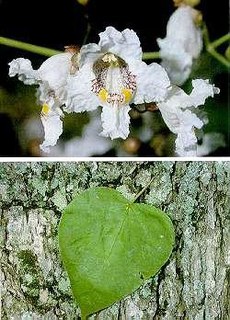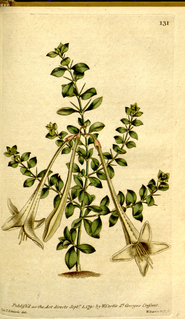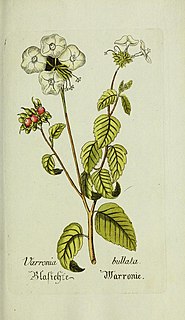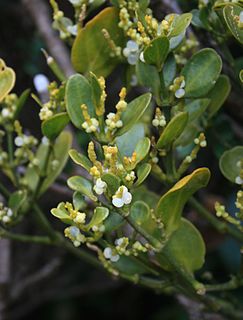
Catalpa, commonly called catalpa or catawba, is a genus of flowering plants in the family Bignoniaceae, native to warm temperate and subtropical regions of North America, the Caribbean, and East Asia.

Rhamnaceae is a large family of flowering plants, mostly trees, shrubs, and some vines, commonly called the buckthorn family. Rhamnaceae is included in the order Rosales.

Plumeria is a genus of flowering plants in the family Apocynaceae. Most species are deciduous shrubs or small trees. The species variously are endemic to Mexico, Central America and the Caribbean, and as far south as Brazil and north as Florida, but are grown as cosmopolitan ornamentals in warm regions. Common names for plants in the genus vary widely according to region, variety, and whim, but frangipani or variations on that theme are the most common. Plumeria is also used as a common name, especially in horticultural circles.
Lasiocroton is a plant genus of the family Euphorbiaceae first described as a genus in 1859. The genus is endemic to the West Indies. It is a member of the Leucocroton alliance, which also includes Leucocroton and Garciadelia. Species in this alliance are dioecious.
- Lasiocroton bahamensisPax & K.Hoffm. - Bahamas, Cuba, Haiti
- Lasiocroton fawcettiiUrb. - Jamaica
- Lasiocroton gracilisBritton & P.Wilson - SE Cuba
- Lasiocroton gutierreziiJestrow - Cuba
- Lasiocroton harrisiiBritton - Jamaica
- Lasiocroton macrophyllus(Sw.) Griseb. - Jamaica
- Lasiocroton microphyllus(A.Rich.) Jestrow - Cuba
- moved to other genera (Bernardia Croton Leucocroton)
- Lasiocroton cordifoliusBritton & P.Wilson - Leucocroton cordifolius (Britton & P.Wilson) Alain
- Lasiocroton prunifoliusGriseb. - Croton punctatusJacq.
- Lasiocroton subpeltatusUrb. - Leucocroton subpeltatus(Urb.) Alain
- Lasiocroton trelawniensisC.D.Adams - Bernardia trelawniensis(C.D.Adams) Jestrow & Proctor
Bonania is a plant genus of the family Euphorbiaceae first described as a genus in 1850. It is native to the West Indies.
- Bonania cubanaA.Rich. - Bahamas, Cuba
- Bonania domingensis(Urb.) Urb. - Haiti, Dominican Rep
- Bonania ellipticaUrb. - Cuba
- Bonania emarginataC.Wright ex Griseb. - Cuba
- Bonania erythrosperma(Griseb.) Benth. & Hook.f. ex B.D.Jacks. - Cuba
- Bonania linearifoliaUrb. & Ekman - Haiti
- †Bonania myricifolia(Griseb.) Benth. & Hook.f. - Guantánamo but extinct

Calyptranthes is a genus of flowering plants in the family Myrtaceae. They are known commonly as lidflowers, spicewoods, and mountainbays. There are about 100 species.

Pimenta is a genus of flowering plants in the myrtle family, Myrtaceae described as a genus in 1821. It is native to Central and South America, Mexico, and the West Indies.

Casasia is a genus of flowering plants in the family Rubiaceae. These shrubs or small trees occur on the Caribbean islands and in one case in Florida. Some of the ten accepted species were formerly placed elsewhere, e.g. in the related genip-tree genus (Genipa), in Gardenia or in Randia.

Exostema is a genus of flowering plants in the family Rubiaceae. It consists of trees and shrubs, endemic to the neotropics, with most of the species occurring in the West Indies.
Wallenia is a genus of plant in the family Primulaceae.

Chaptalia is a genus of flowering plants in the daisy family.

Cleyera is a plant genus consisting of 21 species of tender, evergreen shrubs to small trees, mostly native to Mexico and Central America, and one from Eastern Asia. In the APG III system it is placed in the family Pentaphylacaceae.

Catesbaea is a genus of flowering plants in the family Rubiaceae. It occurs in the West Indies, The Bahamas, and the Florida Keys. The genus is named in honour of English naturalist Mark Catesby.
Thouinia is a genus of flowering plants in the family Sapindaceae. As of 2020 Kew's Plants of the World Online lists 27 species in the genus:

Mitracarpus is a plant genus in the coffee family Rubiaceae. Girdlepod is a common name for some species in this genus.

Crossopetalum, commonly known as Christmas-berries or maiden berries, is a genus of flowering plants in the family Celastraceae. It comprises about 30-40 species.

Varronia is a genus of flowering plants in the family Boraginaceae, found throughout Latin America, the Caribbean, and in the US states of Texas and Florida. They were resurrected from Cordia in 2007.

Dendrophthora, the tree destroyers, is a genus of flowering plants in the sandalwood family Santalaceae, native to tropical and subtropical Latin America and the Caribbean. They are hemiparasitic mistletoes that grow on a wide variety of host plants.
Caiophora is a genus of flowering plants belonging to the family Loasaceae.
This page is based on this
Wikipedia article Text is available under the
CC BY-SA 4.0 license; additional terms may apply.
Images, videos and audio are available under their respective licenses.












